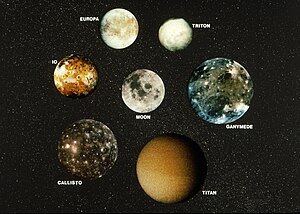
A planetary-mass moon is a planetary-mass object that is also a natural satellite. They are large and ellipsoidal (sometimes spherical) in shape. Moons may be in hydrostatic equilibrium due to tidal or radiogenic heating, in some cases forming a subsurface ocean. Two moons in the Solar System, Ganymede and Titan, are larger than the planet Mercury, and a third, Callisto, is just slightly smaller than it, although all three are less massive. Additionally, seven are larger and more massive than the dwarf planets Pluto and Eris.
The concept of satellite planets – the idea that planetary-mass objects, including moons, are planets – is used by some planetary scientists, such as Alan Stern, who are more concerned with whether a celestial body has planetary geology (that is, whether it is a planetary body) than its solar or non-solar orbit (planetary dynamics).[1] This conceptualization of planets as three classes of objects (classical planets, dwarf planets and satellite planets) has not been accepted by the International Astronomical Union (the IAU).
- ^ "Should Large Moons Be Called 'Satellite Planets'?". News.discovery.com. 2010-05-14. Archived from the original on 2014-10-25.
© MMXXIII Rich X Search. We shall prevail. All rights reserved. Rich X Search
